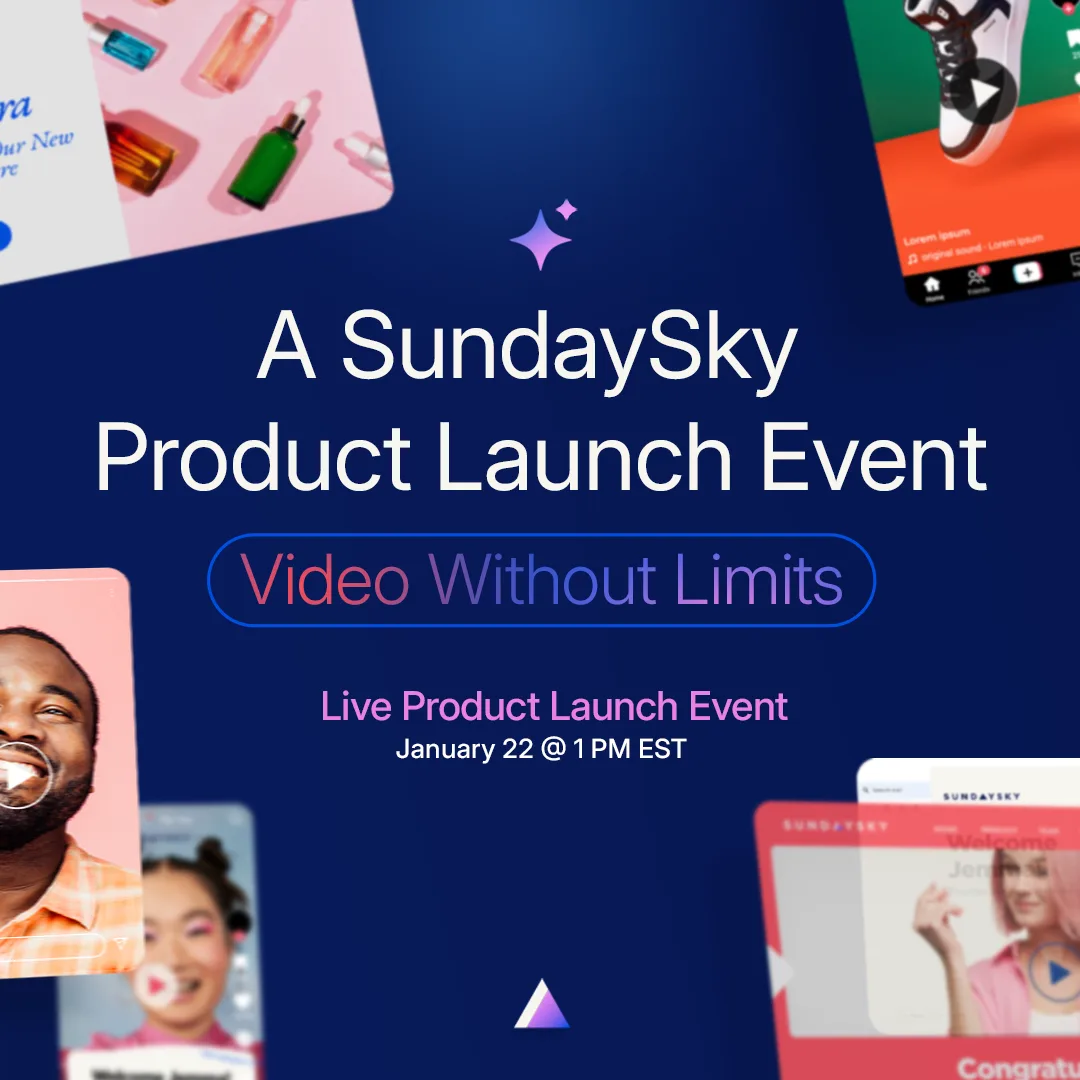The Key 8 Elements of a Winning Video Marketing Strategy
Discover the key elements of a winning video marketing strategy, from goal-setting and content creation to leveraging video marketing statistics for real results.
What if we told you that in 2024, 89% of consumers said they wanted to see more videos from brands? With video delivering up to 10x return on investment, it’s clear that video marketing is a win-win for both businesses and their audiences.
However, as the volume of content grows and consumers are bombarded from all sides, marketers face the challenge of standing out. Video marketing has become one of the most effective tools for cutting through the noise, connecting with audiences, telling compelling stories, and driving measurable results.
Whether you are trying to build brand awareness, increase engagement, or boost conversions, a winning video marketing strategy can help you stand out and achieve your marketing goals.
In this post, we will explore the eight essential elements of a winning video marketing strategy, offering actionable tips to help you create content that connects with your audience and drives real results.
What is Video Marketing?
You may be asking yourself, exactly what is video marketing? Video marketing is the use of video content to promote your products, services, or brand. It involves creating, sharing, and optimizing video content across multiple platforms to engage audiences, drive traffic, and increase conversions.
Unlike static content, video is dynamic and offers delightful opportunities to engage, inform, and convert viewers. Video also aligns well with various stages of the customer journey, from raising awareness through educational videos to driving decisions through product demos or testimonials.
A strong video marketing strategy integrates into nearly every touchpoint—whether it’s through social media, email campaigns, or websites—making it essential for companies looking to stay competitive. As video continues to grow with popular platforms like TikTok, Instagram, and YouTube, it’s more important than ever for businesses to include video in their overall marketing mix.
Video Marketing Statistics
The numbers don’t lie—video marketing is a critical component of any successful marketing strategy. The following key video marketing statistics from Forrestor and SundaySky highlight why video continues to dominate and why businesses should prioritize it in their marketing efforts:
- Higher video consumption: 19% of US online adults report watching 15 hours or more of online video each week, up from 14% in 2021. This growing consumption indicates that audiences are increasingly turning to video for entertainment, information, and purchasing decisions.
- Rising investments in video: 73% of business and tech professionals anticipate that their firm will increase its investment in online video technologies in the next 12 months. This reflects the ongoing shift toward video as a vital tool for communication, marketing, and engagement.
- Increased connectivity: 52% of US online adults reported using an average of six 3D-connected channels, reflecting a multi-channel approach that includes various digital touchpoints, such as social media, websites, and email, where video plays a key role.
- High ROI: 10x return on investment (ROI) and $30 incremental value per video are the results of companies implementing more video content. This makes video one of the highest-performing marketing tools available, delivering measurable business value across industries.
These statistics underscore the growing influence of video in marketing and the significant returns it can offer businesses that strategically invest in video content. For more video marketing statistics, download the Forrester Report: The Ultimate Guide to Selecting the Right Video Platform.
Strategy #1: Define Your Goals and KPIs
A successful video marketing strategy begins with clearly defined goals that align with your broader business objectives. Without this, you risk creating video content that doesn’t support your larger marketing efforts.
Start by asking what you want your videos to achieve. Are you aiming to build brand awareness, increase conversions, or nurture customer relationships?
- Brand awareness: Create videos that introduce your brand and tell a story about your product or service.
- Conversions: Use product demos or explainer videos to move leads further down the sales funnel.
- Customer retention: Produce tutorials and how-to videos that support existing customers, helping them get the most from your product or service.
Once you’ve identified your goals, establish measurable key performance indicators (KPIs) such as views, engagement rates, click-through rates, and lead generation. For example, if you want to increase brand awareness, track how many new visitors come to your website from your video content.
Strategy #2: Understand Your Target Audience
One of the most critical elements of any video marketing strategy is understanding your audience. Creating effective video content begins with a deep knowledge of who your customers are and what they care about. Form this by leveraging data insights from Google Analytics, social media analytics, and customer surveys to map your audience’s preferences.
Detailed audience personas will include:
- Demographics: Age, location, gender, and income all influence how your audience consumes content.
- Interests: What is your audience interested in, what do they care about, and what are their pain points? Understanding these elements helps you tailor your messaging.
- Platform preferences: Knowing where your audience spends their time online is essential for distributing your videos effectively. For example, younger audiences might prefer short-form content on TikTok, while professional audiences may engage more on LinkedIn or YouTube.
Use video marketing statistics to validate trends and behaviors. The results should influence your video content so you know what you’re producing is relevant and meets your target audience.
Strategy #3: Select the Right Types of Videos
Different types of videos serve various purposes, depending on where your audience is in the buying journey. Choosing the right format is essential for delivering the right message at the right time.
Here are some of the most effective types of video content:
- Explainer videos: Simplify complex topics, making them easy to understand.
- Product demos: Showcase your product’s features and benefits in action.
- Testimonials: Provide social proof by featuring satisfied customers.
- Tutorials: Offer step-by-step guidance on using your product or service.
- Live streams: Engage with your audience in real-time, creating opportunities for interaction.
Each type of video serves a different stage of the buyer’s journey:
- Awareness stage: Focus on high-level explainer videos to educate your audience about a problem or opportunity.
- Consideration stage: Product demos and tutorials help prospects evaluate whether your solution meets their needs.
- Decision stage: Testimonials and case studies offer the social proof needed to close the deal.
By matching video types to the customer journey, you ensure that each piece of content is relevant and timely, increasing the likelihood of driving conversions. Download The 10 Commandments of Video, an eBook on video content best practices to learn more.
Strategy #4: Build a Video Content Calendar
Consistency is key to maintaining audience engagement, and a well-planned video content calendar ensures you stay on track. A content calendar helps you schedule videos in advance, providing a steady flow of content that aligns with your marketing goals.
When building your content calendar:
- Plan for seasonality: To stay relevant, align video content with key dates, events, and industry trends.
- Mix evergreen and campaign-specific content: Evergreen videos provide lasting value, while campaign-specific videos drive short-term goals like product launches or promotions.
- Post consistently: Stick to a consistent publishing schedule, whether it’s weekly, bi-weekly, or monthly, to build anticipation and maintain audience engagement.
Tools like Trello, Asana, or HubSpot’s content calendar can help streamline your video planning process and ensure you’re delivering the right content at the right time.
Strategy #5: Optimize Videos for SEO and Content Distribution
For your videos to reach the right audience, they need to be discoverable. That’s where search engine optimization (SEO) comes in. Optimizing your videos for search engines will help you increase visibility and attract more viewers.
Here are some essential tips for optimizing video content:
- Keyword research: Use tools like Google Keyword Planner or SEMrush to identify relevant search terms. Incorporate these keywords into your video titles, descriptions, and tags.
- Compelling thumbnails: Create visually appealing thumbnails that entice viewers to click.
- Mobile optimization: Ensure your videos are optimized for smaller screens, load quickly, and provide a seamless viewing experience.
Google frequently updates its SEO guidelines, so it’s essential to stay informed about the latest best practices for optimizing your video content marketing. Keeping your videos SEO-friendly will help ensure better visibility and engagement across search engines. For more tips on optimizing video distribution, download the Video Distribution and Delivery Channel Tips eBook.
Strategy #6: Develop a Cross-Channel Video Promotion Strategy
To get the most out of your video content, you need a cross-channel promotion strategy. This ensures that your videos reach a broader audience across multiple touchpoints.
Consider these cross-channel strategies:
- Social media: Share video content on platforms like Facebook, LinkedIn, Instagram, TikTok, and YouTube to expand reach.
- Email marketing: Include videos in your email campaigns to boost click-through rates. Simply including the word “video” in a subject line can increase open rates by 65%.
- Paid ads: Consider paid promotions to reach a wider audience and drive engagement.
In addition to utilizing these channels, also consider repurposing content for different channels can maximize your ROI. For instance, a long-form YouTube video can be edited into shorter clips for Instagram or TikTok, or transformed into a blog post for your website.
Strategy #7: Using Video Analytics to Measure Performance
Tracking video performance is essential to understanding what’s working and what needs improvement. Video analytics tools like Google Analytics, YouTube Analytics, and social media insights can help you monitor key metrics such as:
- Watch time: Measures how long viewers watch your video.
- Engagement: Looks at likes, shares, comments, and overall interaction.
- Conversion rates: Tracks how many leads or sales your video generates.
Use these insights to optimize your future videos. For example, if your videos have high views but low engagement, consider making them shorter or adding stronger calls-to-action to boost interaction. For more advanced insights, explore the blog on how AI video analytics is revolutionizing video content marketing strategies.
Strategy #8: Leverage Emerging Trends and Video Marketing Technologies
Staying ahead of emerging video trends and up-to-date on the latest technologies is crucial to being competitive. Some of the latest trends and technologies in video marketing include:
- AI-generated video content marketing: AI tools like SundaySky’s AI Video Platform, can help automate video production, creating personalized video content at scale.
- Shoppable videos: Videos that allow users to make purchases directly within the video, streamlining the buyer’s journey.
- Interactive videos: These allow viewers to make choices that influence the content they see, creating a more personalized experience.
For small businesses, adopting AI-powered technologies such as personalized video creation or using platforms like Instagram’s shopping feature can enhance customer engagement and improve results.
Conclusion
Creating a winning video marketing strategy requires thoughtful planning, consistency, and a deep understanding of your audience. By following these eight key elements—defining goals, knowing your audience, choosing the right video formats, building a content calendar, optimizing for SEO, developing cross-channel marketing, and leveraging emerging technologies—you can create compelling video content that drives results.
Now that you have the tools to build a successful video marketing strategy, it’s time to take action. Download our free guide, The 10 Commandments of Video, to start planning your next campaign and make the most of video’s potential to connect with your audience.






